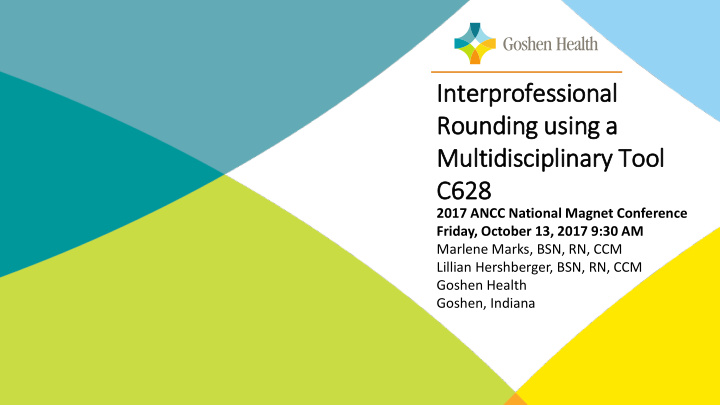



In Inte terprofessional Rounding using a Mult ltidisciplinary Tool C628 2017 ANCC National Magnet Conference Friday, October 13, 2017 9:30 AM Marlene Marks, BSN, RN, CCM Lillian Hershberger, BSN, RN, CCM Goshen Health Goshen, Indiana
The presenters for this presentation have disclosed no conflict of interest related to this topic.
Goshen Health Goshen Health Hospital demographics 125 beds; 3-time Magnet Designated
Accountable Care Organization Goshen Health • Indiana Lakes Accountable Care Organization – Comprised of Goshen Health System and the Medical Staff(PHO) – 200 physicians in a Clinically Integrated network – Medicare SSP(10,000 lives) + Medicaid(5000 lives)+Commercial ACO (20,000 lives)
Goshen Health Payer Mix Goshen Health AMISH Commercial Workman’s Comp Medicare HMO Medicare Self Pay Blue Cross Blue Shield Indiana Medicaid Contracted Payers
The Uncommon Leader (TUL) Culture The Uncommon Leader (TUL) culture at Goshen Health is the foundation through which every Colleague has a voice . Colleagues are empowered to make a difference in the lives of our patients, our communities and each other. In turn, every Colleague has a responsibility to raise their voice for positive change throughout the organization.
Acute Care Coordination
Acute Care Coordination • Nurse driven model with collaboration with social work • 9 Registered Nurses • 4 Social Workers • 2 Support Colleagues • Roles • Transitional care planning • Utilization Review • Connecting patients to community resources • Denials Management • Identify opportunities to improve quality of care • Goals • Reducing readmission rates by identifying gaps in care • Collaborate with hospital and community partners • Maximizing revenue through appropriate statusing • Unit based
Improvement Opportunities • High readmission rate • Patients not involved in developing the plan of care • Fragmented communication • Non-interprofessional approach • Delayed discharges
Something had to give
TUL Culture: Rapid Improvement Event
A3 Thinking 1. Reasons for 7. Completion 4. Gap analysis Action plan 5. Solution 8. Confirmed 2. Initial state approach state 6. Rapid 3. Target state 9. Insights experiments
Reasons for action In today's acute care environment treatment plans are complex and require interdisciplinary coordination and care. Many elements of our current process are fragmented, which results in misinformed patients families and staff, redundancies and omissions in the plan of care and increased length of stay . In order to optimize outcomes and efficiency, we need to involve the patient and develop a standard process for a core group of disciplines to address patient-driven healthcare goals .
Initial state • Uti lized interprofessional team – Pharmacy – Dieticians – Therapy – Respiratory therapy – Bedside RN • Hospitalist participation Current State Target 30 Day 60 Day “Core” group of professionals No Process present for daily rounding Patient driven healthcare goal No Process documented
Target state • Coordinated communication among professionals • Patient-driven healthcare goals discussed and documented • Core team of professionals rounding at patient’s bedside Current State Target 30 Day 60 Day “Core” group of professionals No Process 80% present for daily rounding Patient driven healthcare goal No Process 80% documented
Gap analysis Gap Suspected Root Cause Communication among professionals is Participation in rounding is inconsistent fragmented, impacting the ability of caregivers to develop a comprehensive plan Documentation of disciplines in silos of care Bedside nurses feel unavailable or Bedside nurses have approximately 26 unequipped for rounds with the hospitalist minutes more work to do between the hours of 8-11 a.m. than they have time available Proposed CMS regulation requiring Did not have a patient centered approach documentation of patient driven goal
Solution approach • Bring the “Core Team,” including the Nurse Care Coordinator, into the bedside rounds with each hospitalist and nurse • Leverage resources by utilizing our EMR; Combine pertinent caregiver assessments into a single-page interprofessional rounding intervention in Meditech easily accessible by all • Clearly define expectations for what a nurse needs to contribute during rounding • Identify ways to make rounds value add for everyone present • Identify a process for discussing and documenting patient- driven goals
Documentation Tool Presenting this change in process at Magnet Conference 2017
Rapid experiments • All disciplines were not available to round and would be intimidating to patient • Developed “core” group for daily rounds • Reviewing documentation of all disciplines during rounds was cumbersome and time-consuming • Single-page interprofessional rounding document • Identified unit based model would not allow for Nurse Care Coordinator to round with all patients, Hospitalist, and bedside RN • Hospitalist based model • Attempted to use paper Cardex • Nurses did not feel more informed at rounds • Dual documentation • Asked providers to discuss patient driven healthcare goal • Identified additional education needed
Overcoming Implementation Barriers Bedside nurse NCC Patient Hospitalist provider Input from other professionals
Insights • Open computer at the bedside • Enter orders • Gather information • Document in real-time • “Core” teams participation engaged the entire team • Reduced phone calls to provider and nurse care coordinator • Decreased re-work of having to communicate plan multiple times • Decreased delayed discharges • Patient’s engaged in developing plan of care • Identified collaboration between care team • Streamlined process for patients to identify needs or questions • Provided opportunity for families to attend rounds • Diversity and representation of all professions on team • Quick implementation lead to continued momentum
Confirmed state Initial Target RIE 30 60 # Pillar Metric % Week 3/14 3/21 3/28 4/4 4/11 4/18 4/25 5/2 5/9 5/16 State State day Day Core group of professionals No 100.0 80% Service present for daily process % COMMUNICATION WEEK rounding 1 92% 77% 92 82 91 86.0 94.0 94.0 91.0 89.0 92.0 93.0 Patient-driven No 100.0 healthcare goals 80% Quality & process % Safety documented 3 53% 93% 95 95 94 95.0 96.0 97.0 94.0 91.0 96.0 98.0
Case Study
Case Study
Presenter Contact Information Marlene Marks, BSN, RN, CCM mmarks@goshenhealth.com 574-364-2918 Lillian Hershberger, BSN, RN, CCM lhershberg@goshenhealth.com 574-364-1377
Recommend
More recommend